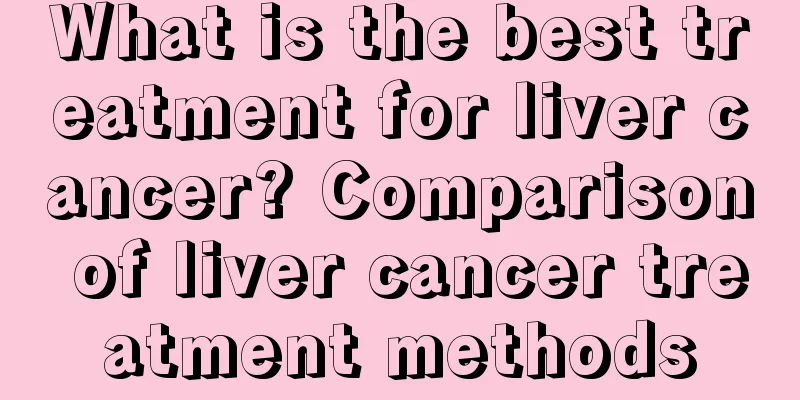What is the best treatment for liver cancer? Comparison of liver cancer treatment methods

|
Liver cancer is a highly malignant tumor. It is morphologically classified into diffuse, mass, nodular and small cancer types. Microscopically, it is divided into hepatocellular carcinoma (about 85%), cholangiocarcinoma (about 7.4%) and mixed type (about 7.6%). The early symptoms of liver cancer are not obvious, and it is often diagnosed in the middle and late stages. The natural survival period of middle and late stage liver cancer is only 2-6 months. Limitations of surgical treatment for liver cancer In recent decades, although surgical treatment of liver cancer has made great progress, only 10% to 15% of newly diagnosed liver cancer patients are suitable for surgery. At the same time, the recurrence rate of liver cancer patients after surgery is very high, and the treatment after tumor recurrence is relatively difficult. Surgical treatment can relatively cleanly remove the primary cancer lesions visible to the naked eye, but it cannot detect the invasion of cancer cells into the portal vein (hepatic vein) in the liver; secondly, bleeding and squeezing during surgery can also cause local implantation of cancer cells and reach distant sites along the blood and lymphatic channels to form micro-metastasis lesions; and surgical trauma can lead to low immunity, etc., which can lead to local recurrence, intrahepatic metastasis and distant metastasis in the future. These are the limitations of surgical treatment of liver cancer. In addition, some patients cannot tolerate surgical resection when the diagnosis is established due to the size and location of the tumor, the basic liver lesions, liver function and the overall condition of the patient. At this time, non-surgical local treatment methods become an important means of treating liver cancer. Advances in radiotherapy technology usher in an era of precise cancer treatment Conventional radiotherapy, as one of the local treatment methods, has backward imaging diagnostic technology and cannot accurately locate tumors. The technology is backward and the irradiation range is large, so too many normal tissues are within the irradiation range and the dose cannot be increased. Therefore, conventional radiotherapy is mostly used for symptom reduction treatment of patients with advanced liver cancer. In recent years, with the development of medical technology, radiotherapy has entered the modern radiotherapy era from the era of conventional radiotherapy. Its progress includes several aspects: the progress of imaging technology provides a platform for modern radiotherapy to correctly hit the target; computer technology is the soul of modern radiotherapy technology to "target"; a variety of radiotherapy equipment including body gamma knife is the key to modern radiotherapy technology; stereo positioning and verification technology is an important link in modern radiotherapy to accurately lock the target; in addition, the dose distribution has been improved, and the dose fractionation mode has changed, which greatly increases the local dose of the tumor and shortens the total treatment time. Four advantages of Gamma Knife in treating liver cancer Compared with surgery, Gamma Knife has four major advantages in treating liver cancer: First, it is less restricted by blood vessels because blood vessels have a high tolerance to radiation. When the tumor infiltrates the blood vessels, surgery is difficult and the treatment is safer; second, it is not restricted by the location of the body. Radiation is pervasive, so radiotherapy can be used for those areas that are difficult to expose during surgery or for important functional areas or areas where the tumor invades and cannot be removed. There is also a chance of radical cure for early small lesions; third, it is non-invasive and has little impact on the whole body, so most patients with poor physical conditions can tolerate it; fourth, it can treat multiple lesions throughout the body. For example, for lung metastasis of liver cancer, radiotherapy can be performed on the primary lesion in the liver while treating the secondary lesions in the lungs. This is the concept of systemic treatment with local means. Principles of liver cancer classification and staging treatment Treatment principles for small hepatocellular carcinoma (subclinical hepatocellular carcinoma) Small liver cancer generally refers to liver cancer in which the maximum diameter of a single cancer nodule in hepatocellular carcinoma does not exceed 3 cm or the sum of the diameters of two cancer nodules does not exceed 3 cm. It can be treated with gamma knife, which has definite efficacy and few side effects. It is especially suitable for patients with small liver cancer who are elderly, weak, have cirrhosis, or cannot undergo surgery, are not suitable for surgery, or do not want surgery for other reasons. Treatment principles for large liver cancer ① For patients with large liver cancer who refuse surgery or cannot be surgically removed, gamma knife treatment can be performed as long as the liver function is basically normal. ② Palliative resection has poor efficacy and high chances of postoperative recurrence and metastasis. It is generally considered when the tumor is too large and there is a high possibility of rupture and bleeding. TACE or modern radiotherapy can be used after surgery. TACE is to embolize the tumor blood supply artery to achieve ischemic necrosis of the tumor, while anti-tumor drugs are slowly released locally in the tumor to play a chemotherapy role. Its disadvantage is that most tumors are not completely necrotic and require multiple treatments. ③ Large liver cancer that has spread into the liver: modern radiotherapy is feasible. ④ Patients with combined portal vein cancer thrombus are prone to esophageal varicose bleeding, liver failure, refractory ascites or spontaneous tumor rupture, which may lead to rapid deterioration or death in a short period of time. Those who have the conditions should not give up treatment easily. Gamma knife treatment of vascular cancer thrombus can mostly alleviate the condition and prolong life. ⑤ If accompanied by jaundice and ascites, the ascites can be drained first, and then the jaundice can be reduced through drainage or stenting, and then gamma knife radiography can be performed on the local mass. ⑥ Patients with liver decompensation due to large liver cancer should only be treated with immunotherapy, biological therapy or traditional Chinese medicine. In a few cases, TACE or modern radiotherapy can be performed while protecting the liver or during liver protection treatment, and after liver function improves. Special treatments for liver cancer Gamma Knife and interventional therapy for liver cancer: Gamma Knife and interventional therapy for liver cancer can complement each other's shortcomings and achieve better results. Interventional therapy before Gamma Knife therapy can shrink the tumor, creating conditions for Gamma Knife to kill more tumor cells; secondly, the reduction of the tumor can reduce the irradiation volume of Gamma Knife and reduce radiation side effects; chemotherapy drugs used in interventional therapy can synergize or sensitize Gamma Knife. In addition, interventional therapy kills a certain number of cancer cells, prompting the remaining non-proliferative cells to enter the proliferative phase, which is beneficial to the reoxygenation of hypoxic cells, thereby increasing the sensitivity of radiotherapy and increasing the killing effect of Gamma Knife therapy. Gamma knife combined with heat therapy to treat liver cancer: The combined use of heat therapy and radiotherapy can significantly increase the killing rate of tumor cells. Indications for Gamma Knife in the treatment of liver cancer The general condition is good; for a single lesion in the liver with a diameter of less than 5 cm or a large lesion and several small lesions confined to one lobe of the liver, the total volume does not exceed 60% of the liver volume; no obvious cancer thrombus is found in imaging examinations; liver function is basically normal, and cirrhosis is not obvious; liver cancer patients without distant metastasis can undergo radical gamma knife treatment. Gamma Knife can be used to treat intrahepatic lesions larger than 5 cm, or multiple lesions that account for more than 60% of the total liver volume; cancer thrombi in the main trunk or left or right branches of the portal vein; obstructive jaundice in tumors near the portal area; whether the primary lesion is controlled or not, there are lung, bone, lymph node metastases or compression symptoms; and liver cancer patients who have undergone surgery or interventional treatment, have residual tumors that are not controlled, or have spread within the liver, can allay symptoms or stabilize the development of lesions. Contraindications of Gamma Knife for the treatment of liver cancer ① Relative contraindications: If the ascites is under control after conservative treatment, Gamma Knife treatment can still be performed; if jaundice exists, if the jaundice disappears or is significantly alleviated after jaundice reduction treatment, Gamma Knife treatment can be performed; if the liver function is abnormal, such as ALT elevation, albumin below 35g/L, and prothrombin time prolonged, and it basically returns to normal after treatment, Gamma Knife treatment can still be considered. ② Absolute contraindications: Bleeding tendency; symptoms of upper gastrointestinal bleeding; obvious liver cirrhosis, hypersplenism, and blood picture below normal; extremely poor general condition, KpS score below 40 points; huge or extensive intrahepatic lesions, accompanied by jaundice, ascites or multiple metastases; accompanied by hepatic coma. Gamma Knife Treatment for Liver Cancer Since the gamma knife can give a very high radiation dose to the tumor area with minimal damage to the normal tissue around the tumor, the local control rate is high. Generally, the CT scan is repeated every 1 to 3 months, and the effective rate of liver cancer treatment is between 60% and 88.7%, and the effective rate of quality of life can reach 88.9%. From August 2000 to December 2006, the Department of Radiotherapy of the Air Force General Hospital used body gamma knife to treat 148 cases of liver cancer of different stages. The 1-, 2-, and 3-year overall survival rates were 82.2%, 79.0%, and 49.6%, respectively, which fully demonstrated that the body gamma knife can achieve a high local control rate and survival rate for early liver cancer that cannot be operated on, and has few side effects. Nursing of Radiotherapy for Liver Cancer For patients with advanced liver cancer who cannot be surgically removed, chemotherapy is currently the best method. Chemotherapy has achieved good results in anti-tumor, but because chemical drugs not only kill tumor cells, but also normal cells, causing adverse reactions in the body, nurses should understand the side effects of chemotherapy and provide corresponding care. 1. Nursing before chemotherapy 1. Provide psychological care. Provide health education before chemotherapy, explain the various side effects that may occur during chemotherapy and the effects that can be achieved, so that patients can face the treatment and build confidence. 2. Make various preparations before chemotherapy according to the doctor's instructions, such as liver and kidney function tests, blood coagulation time tests, etc. 3. Provide special care according to different routes of administration. For example, for hepatic artery perfusion, skin preparation and iodine tests should be done. 4. Before chemotherapy, patients should strengthen nutrition, eat more high-protein, high-calorie, and high-vitamin foods, and provide supportive treatment according to the doctor's instructions when necessary. 2. Nursing during chemotherapy Nursing during chemotherapy mainly focuses on the key points of nursing for chemotherapy drugs: 1. Understand the condition, chemotherapy regimen, administration method, drug dosage and possible side effects, etc. 2. Drugs should be prepared and used immediately. 3. When administering drugs intravenously, the selection of veins should be planned, and puncture should be started from the distal end of the vein. First flush with normal saline to make sure the needle is in the vein. Administration should be slow to reduce the occurrence of side effects. 4. Strictly implement aseptic operation techniques, change the injection site frequently, and prevent thrombophlebitis. 5. After the injection, flush with normal saline to reduce stimulation to the blood vessels. 6. After intrahepatic arterial infusion surgery, the wound should be bandaged with pressure, and the patient should be absolutely bedridden for 24 hours. The limb on the operated side should be straightened and kept still to prevent bleeding. 3. Post-chemotherapy care 1. Closely observe the drug reaction and assist the doctor in dealing with the toxicity of various chemotherapy drugs. 2. Encourage eating. Liver cancer patients often experience nausea, vomiting, and loss of appetite due to the effects of chemotherapy drugs. Guide the patient to eat high-protein, high-calorie, high-vitamin liquid or semi-liquid diets in a planned manner, eat small meals frequently, and reduce irritation to the stomach. 3. Regularly monitor blood counts. For patients with severe leukopenia and bone marrow suppression, active infection prevention and protective isolation measures should be taken. 4. Treatment of drug leakage. Different secondary antagonists should be selected according to different drugs. For doxorubicin and vincristine, dexamethasone 5mg or sodium carbonate 5ml can be used; and the affected limb should be raised; local cold compress for 24 hours. If local ulceration occurs, surgical dressing should be changed. 5. If there are systemic adverse reactions, contact the doctor and treat the symptoms. 6. Patients with hair loss should pay attention to keeping the bed clean, do not make fun of the patient, and persuade him to wear a wig. |
>>: How is advanced liver cancer treated? Three common treatments for advanced liver cancer
Recommend
What is sexual fantasy
Sex is an indispensable process in daily life for...
Exercises to mobilize the cervical spine
The main cause of cervical spondylosis is long-te...
Men with prostate cancer should eat three kinds of fruits
Prostate cancer is a pain for men. Men can preven...
Hot towels can cure ten common diseases
When applying hot compress, you should choose a c...
Ankle joint pain
Many middle-aged and elderly people suffer from j...
How to diagnose primary liver cancer? This test can diagnose primary liver cancer
Alpha-fetoprotein (α-fetoprotein, αFp or AFp) is ...
Will dental implants hurt?
Dental implants are an effective and best way to ...
How long does it take to take Chinese medicine after bladder cancer surgery
How long should I take Chinese medicine after bla...
Feeling blocked in esophagus after eating
Many people always feel uncomfortable and blocked...
What are the specific effects of purple grape seed soft capsules
In pursuit of beautiful skin, girls all know to c...
Treatment methods for sequelae of knee replacement
In the last century, medicine was not well develo...
Japanese encephalitis vaccine can easily cause fever
The Japanese encephalitis vaccine is an antibioti...
Massage skills and techniques_Basic techniques of Tuina massage
Massage is a common method of massage in traditio...
Steps for soaking carambola
Carambola is a fruit that is very nutritious, has...
What are the symptoms of bacterial enteritis?
There are other types of enteritis. Bacterial ent...









